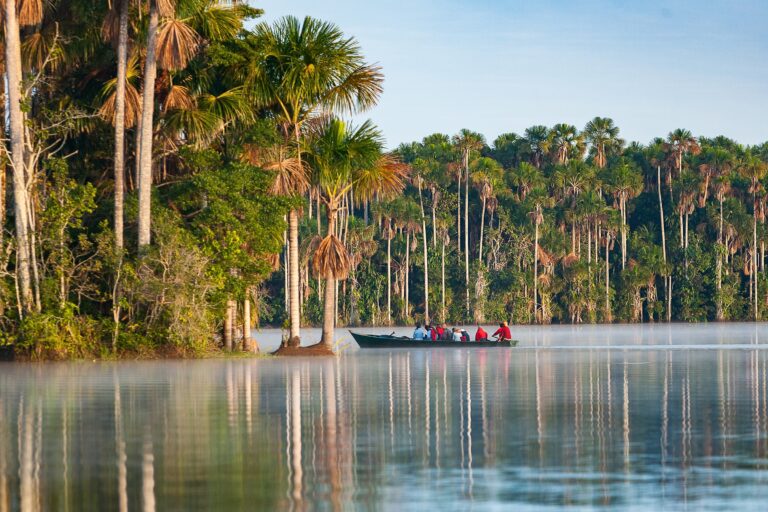Too big to fail: tropical forests as anchors of economic prosperity and resilience

Nicola Ranger and Emma O’Donnell explain why tropical forests should be designated as ‘Global Systemically Important Natural Systems (G-SINS)’ – essential to global economic security and financial stability – and ask if and how the proposed Tropical Forest Forever Facility (TFFF) could anchor a new global architecture for financing nature and resilience.
Global prosperity and security depend on natural systems that regulate the climate, supply food and water, and underpin financial stability. These critical natural systems range from tropical forests to coral reefs and river deltas: and they are at risk of collapse due to human pressures, including deforestation, pollution, overexploitation and climate change.
The loss of these critical natural systems would not only devastate livelihoods and biodiversity but could also generate global cascading economic shocks larger than the 2008 global financial crisis, as highlighted in our previous work with the Network for Greening the Financial System (NGFS). Human security, food systems, macroeconomic stability and the achievement of the Paris Agreement and Kunming-Montreal Global Biodiversity Framework (GBF) goals are all at stake.
Introducing ‘Global Systemically Important Natural Systems’ and the TFFF
Just as the 2008 financial crisis prompted the designation and regulation of Global Systemically Important Banks (G-SIBs), we ask if the world similarly needs to identify and safeguard ‘Global Systemically Important Natural Systems’ (G-SINS) – those, like the banks, that are ‘too big to fail’. With COP30 this year hosted in the world’s largest tropical rainforest – the Amazon – and a spotlight on forest finance, could recognising and designating tropical forests as G-SINS help to mobilise investment in the large-scale protection and restoration?
This is not just theory. For COP30 in Belém, the Brazilian Presidency is launching the Tropical Forest Forever Facility (TFFF), designed to channel large-scale, predictable finance into protecting tropical forests, rewarding countries for forest stewardship while mobilising private and public capital.
The TFFF raises many questions, not least whether it can raise the US$125 billion of capital it needs to generate sufficient returns to deliver the promised US$4 per hectare annually to eligible countries. At a time of fiscal strain and economic uncertainty, 125 billion is a big number. But, we argue that when seen through a ‘G-SINS’ lens, the TFFF – and forest finance more widely – becomes more than a climate or biodiversity initiative: it becomes ‘systemic risk management’ for the financial system, the global economy and planet.
Forests as global critical natural infrastructure
In his new book, Professor Lord Nicholas Stern makes the case that at a national level, ecosystems are like critical infrastructure, providing water, fertile soils, disaster protection and natural resources that underpin economic development and safeguard lives and livelihoods. Like other infrastructure, they are productive assets that contribute to growth. The tropical forests of the Amazon, Congo Basin and Southeast Asia support the livelihoods of more than 150 million people and are home to thousands of endemic species.
A growing body of research shows clearly that tropical forests also act as global macroeconomic stabilisers. For example, our previous research with the Green Finance Institute and partners showed that nature-related risks could cost the UK economy 6–12% of GDP within a decade, with half of this risk coming from nature loss overseas via trade and investment.
The world’s tropical forests are clear candidates for ‘G-SINS’ designation. The recent Global Tipping Points report highlights that the Amazon “is both a biodiversity hotspot and essential for regional and global climate stability, playing a central role in moisture recycling, cloud formation, and energy transport”. Together, the moist tropical forests drive over 20% of water provision regionally and sequester around 3 gigatonnes of carbon annually and store well over 250 gigatonnes – enough to accelerate global climate change far past 1.5 or 2-degree targets and materially increase GDP impacts if it were released back into the atmosphere. As Sir David Attenborough summarised in Professor Sir Partha Dasgupta’s seminal report for the British government, “The natural world supplies us with every oxygen-laden breath we take and every mouthful of food we eat… we are currently damaging it so profoundly that many of its natural systems are now on the verge of breakdown.”
As well as regulating the climate, these forests are significant to global supply chains of critical materials – with the Democratic Republic of the Congo producing 70% of the world’s cobalt and tropical forest countries in Southeast Asia producing 97% of the world’s rubber and 83% of the world’s palm oil, for example. Their loss would create systemic risks across energy, trade and financial systems, with impacts that could dwarf previous financial crises.
Yet despite their critical importance, the threat to tropical forests persists, with several countries seeing continued high rates of forest loss. The World Resources Institute reports that forest loss in 2024 alone caused 3 gigatonnes of carbon dioxide emissions, more than the annual emissions from India’s fossil fuel use. Recent research reported in Nature Climate Change found that deforestation across the Amazon, African and Asian rainforests has already caused local warming of almost 0.5ºC, linked to 28,000 heat-related deaths.
Designating tropical forests as G-SINS could help to mobilise investment
One important cause of past failures to protect these rainforests has been inadequate finance for protection. The UN Environment Programme’s State of Finance for Forests 2025 report reveals only US$85 billion in annual finance flows for forest protection versus over $400 billion in damaging environmental subsidies, and cites Global Canopy’s estimate of US$9 trillion in active financing being provided by private financial institutions to companies with the highest deforestation risk as of November 2024. Of the current forest-positive financial flows, only $8 billion is private investment.
The fact that financing tropical forests benefits not only people and biodiversity but also investors, banks and insurers themselves is often forgotten. Preventing deforestation and investing in G-SINS is systemic risk management.
For example, our research and research by the European Central Bank shows that banks and investors are shooting themselves in the foot by financing companies with high deforestation risk – propagating nature risks that they are then exposed to themselves. The NGFS calls these ‘endogenous risks’.
‘G-SINS’ is a purposely financial choice of language for something non-financial. At Earth Capital Nexus – the new nature finance initiative at LSE – we are crunching the numbers and working with scientists, economists, regulators, governments and financial institutions to explore if by framing the tropical forests as G-SINS, beyond becoming conservation priorities they can be hard-coded in how financial institutions price and allocate capital. This would rightly reflect tropical forests’ status as systemic assets essential for global economic stability, in turn helping to steer capital away from activities with high deforestation risk and towards forest protection and restoration.
G-SINS to support the TFFF – a systemic risk solution for the planet
How could the G-SINS concept help to mobilise investment in mechanisms like the TFFF? Firstly, anchoring the TFFF within the G-SINS framework strengthens the investment case. It transforms the instrument from a conservation tool into a mechanism for economic security and financial stability – the first of its kind.
Recognition of G-SINS by governments and international financial institutions could help to mobilise even greater investment – including concessional and blended finance for this critical public good – and redirect harmful subsidies.
For central banks and regulators, encoding nature into how firms price and allocate capital becomes a means to manage systemic risks. As explained by the NGFS, “the degradation of nature, and actions aimed at preserving and restoring it, can have material macroeconomic, macroprudential, and micro-prudential consequences.” Based on this logic, it could justify regulatory incentives for G-SINS-aligned investments, such as lower capital charges. For example, recognition of G-SINS within prudential frameworks – analogous to how G-SIBs receive special oversight – could enable supportive regulatory treatment for G-SINS investments like the TFFF, unlocking a radical upscaling of private capital.
From an important step to a giant leap forward?
TFFF is an important step in safeguarding the lives and livelihoods of forest communities and biodiversity. But it could also be a giant leap forward in embedding nature at the heart of the global economy and financial system. Over time, the G-SINS lens could extend to ecosystems beyond tropical forests, making TFFF a prototype for valuing natural systems as macro-critical assets within global finance and governance. Recognising and investing in G-SINS could become one of the defining economic reforms of our generation – ensuring that nature stability is treated as global stability.
This commentary underwent some minor amendments on 10 November 2025 to adjust some of the terminology and correct the attribution to the quote from the Dasgupta Review.

